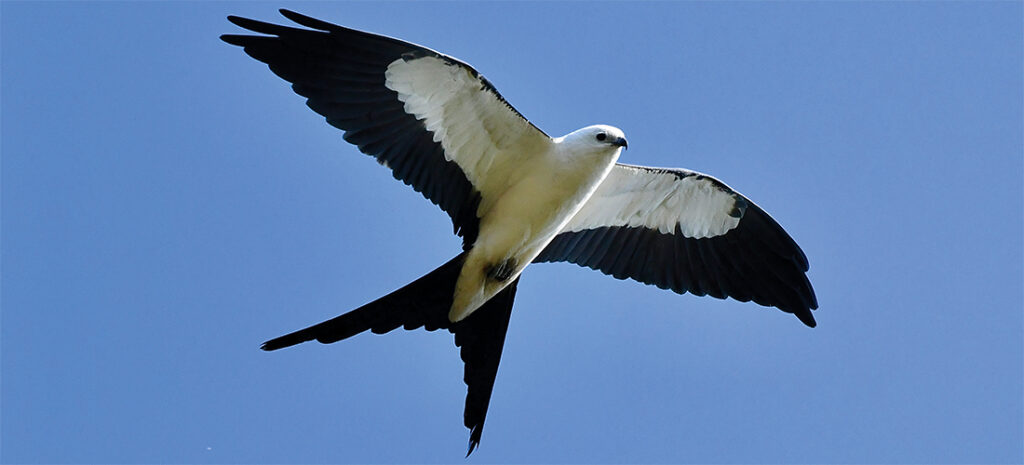Birdwatch

A Soaring Kite
The majestic swallow-tailed
By Susan Campbell
The swallow-tailed kite is, without a doubt, the most unmistakable of birds in our state — and perhaps anywhere in the world. This large raptor with a long, forked tail is capable of endless, highly acrobatic flight. The size, as well as the long, narrow wings, may cause one to think “osprey” at first, but one glimpse of that unique tail gives its true identity away, even at a great distance. This majestic bird is black on top with a white head and belly, as well as white wing linings. As with all kite species, the bill is stout and heavily curved, but the legs and feet, instead of being yellow, are a grayish hue.
It has only been in the last decade that this magnificent species has become a regular in the summer months in certain locations of southeastern North Carolina. Individuals were observed mixed in with Mississippi kites along the Cape Fear River in the summer of 2003. In 2008 a pair of kites seemed to be defending a territory along the river, but no concrete evidence of breeding could be found. Swallow-tailed kites were finally confirmed as a new breeder here when a nesting pair was located during an aerial survey by the N.C. Wildlife Resources Commission in May of 2013. Far more likely to be seen in coastal South Carolina and farther south, these birds have plenty of feeding habitat here, as well as tall trees for nesting. Their numbers are bound to increase in the years ahead.
Swallow-taileds are found in wet coastal habitat where their preferred prey — large flying insects — are abundant. Adults feed entirely on the wing. But, when foraging for young, this bird is so agile that it not only preys on bugs, such as dragonflies and beetles, it readily snatches snakes, lizards and even nestlings of other species from the canopy. Swallow-taileds are not at all choosey. Males forage for a good deal of the food for the growing family. The male will carry food items back to the nest in its talons, transfer to it to his bill and carefully pass it to his mate, who will tear it into pieces and feed it to their young.
This species is a loosely communal breeder like its cousin the Mississippi kite. Swallow-tailed pairs can be seen in adjacent treetops when they find a particularly good piece of habitat. Non-breeding males may also associate with established pairs. These individuals might bring gifts of sticks and even food to breeding females but, interestingly, these offerings usually go ignored.
Swallow-taileds have been found to consume a large number of highly venomous insects. Wasps and hornets are not uncommon food items, as are fire ants. This is possible because they have developed a much fleshier stomach than other birds. An adult kite may bring an entire wasps’ nest to its own nest and, after consuming the larvae, incorporate it into the nest. The motivation for this behavior is unclear.
In late summer, individual swallow-tailed kites can be seen almost anywhere in the state as a result of post-breeding dispersal. They may mix in with feeding or loafing Mississippi kites around agricultural fields or bottomland forest. Last July, I was fortunate enough to spot a soaring individual over Highway 421 adjacent to swampy habitat outside of Siler City in Chatham County. Should you spot one of these magnificent birds, consider yourself very lucky. OH
Susan Campbell would love to receive your wildlife sightings and photos. She can be contacted by email at susan@ncaves.com, or by calling (910) 585-0574.
